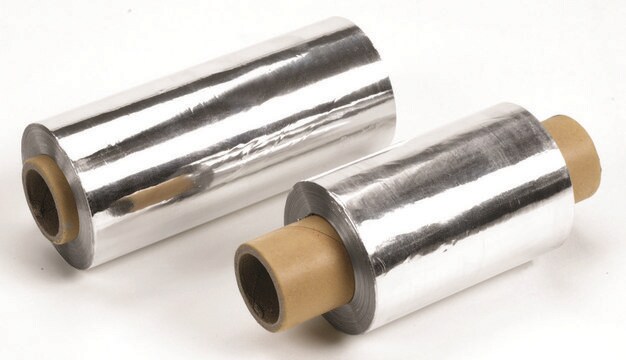おすすめの製品
品質水準
アッセイ
99.999% trace metals basis
フォーム
foil
自己発火温度
1400 °F
抵抗性
2.6548 μΩ-cm
厚さ
1.0 mm
bp
2460 °C (lit.)
mp
660.37 °C (lit.)
密度
2.7 g/mL at 25 °C (lit.)
アプリケーション
battery manufacturing
SMILES記法
[Al]
InChI
1S/Al
InChI Key
XAGFODPZIPBFFR-UHFFFAOYSA-N
関連するカテゴリー
数量
保管分類コード
11 - Combustible Solids
WGK
WGK 3
引火点(°F)
Not applicable
引火点(℃)
Not applicable
個人用保護具 (PPE)
Eyeshields, Gloves, type N95 (US)
適用法令
試験研究用途を考慮した関連法令を主に挙げております。化学物質以外については、一部の情報のみ提供しています。 製品を安全かつ合法的に使用することは、使用者の義務です。最新情報により修正される場合があります。WEBの反映には時間を要することがあるため、適宜SDSをご参照ください。
労働安全衛生法名称等を通知すべき危険物及び有害物
名称等を通知すべき危険物及び有害物
Jan Code
266957-1EA:
266957-1EA-PW:
266957-6.8G:
266957-BULK:
266957-27.2G:
266957-VAR:
266957-27.2G-PW:
この製品を見ている人はこちらもチェック
資料
In many technologies, performance requirements drive device dimensions below the scale of electron mean free paths (λe). This trend has increased scientific interest and technological importance of electrical resistivities at the nanoscale.
Can there be an effective strategy for finding breakthrough materials, since they are, by definition, unpredictable? One answer is found in Combinatorial Materials Science techniques, which represent a powerful approach to identifying new and unexpected materials.
Biomedical implants are essentially foreign substances within the human body that must survive many years’ exposure to demanding mechanical and physiological conditions. Despite these challenges, metal implants have been widely used to substitute for or rebuild hard tissues such as bones and teeth.
Biomedical implants are essentially foreign substances within the human body that must survive many years’ exposure to demanding mechanical and physiological conditions. Despite these challenges, metal implants have been widely used to substitute for or rebuild hard tissues such as bones and teeth.
Global Trade Item Number
| カタログ番号 | GTIN |
|---|---|
| 266957-6.8G | |
| 266957-1EA | 4061826705131 |
| 266957-27.2G |
ライフサイエンス、有機合成、材料科学、クロマトグラフィー、分析など、あらゆる分野の研究に経験のあるメンバーがおります。.
製品に関するお問い合わせはこちら(テクニカルサービス)


